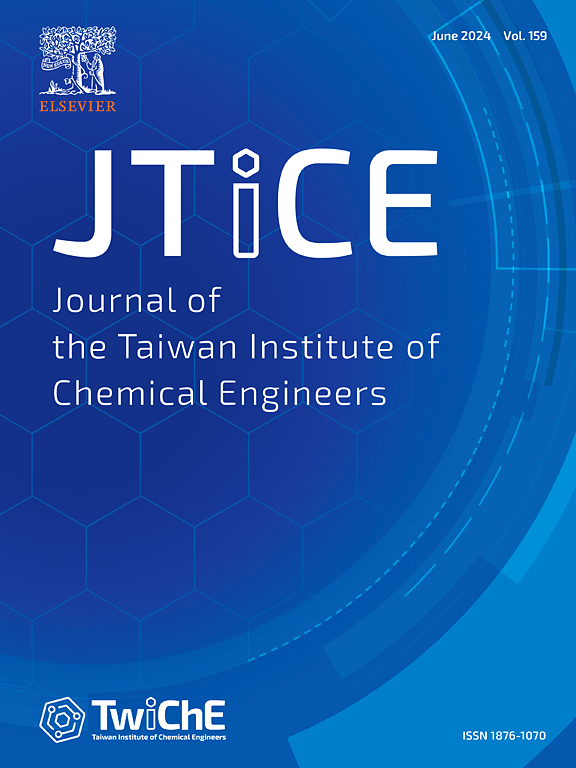Chan−Lam cross-coupling between boronic acids and sulfonyl azides mediated by the combination of heterogeneous catalyst Cu-USY and NaBH4
IF 5.5
3区 工程技术
Q1 ENGINEERING, CHEMICAL
Journal of the Taiwan Institute of Chemical Engineers
Pub Date : 2025-06-28
DOI:10.1016/j.jtice.2025.106255
引用次数: 0
Abstract
Background
The Chan-Lam cross-coupling reaction represents one of the most versatile and promising methods for C − N bond construction in chemistry. However, designing effective and stable catalysts remains challenging.
Method
Cu-USY was prepared from ultra-stable Y (USY) zeolite as the framework and characterized by X-ray diffraction (XRD), scanning electron microscopy (SEM), transmission electron microscopy (TEM), X-ray photoelectron spectroscopy (XPS). thermogravimetric analysis (TGA) etc. The catalytic performance was investigated through the reaction of phenylboronic acids and sulfonyl azides in the absence of ligand, with products characterized by NMR. Mechanistic studies was conducted accordingly.
Significant findings
It has been proved that Cu was well immobilized on the surface and internal cages of USY to enhance the selectively, and in this case, the homocoupling of boronic acids was greatly suppressed. The experimental observations and mechanistic studies indicated that NaBH4 played dual roles as both base to promote the N2 release/nitrene formation and reductant to regenerate Cu(I) species in situ. Notably, our method exhibits broad functional groups tolerance, demonstrating good potential in organic synthesis and molecular modification. This work provides an alternative strategy for the synthesis of high performance and recyclable heterogeneous Cu catalyst with good potential practicalities during the C − N bond formation.

Cu-USY和NaBH4复合非均相催化剂介导的硼酸与磺酰叠氮化物间的Chan - Lam交叉偶联
Chan-Lam交叉偶联反应是化学中最通用和最有前途的C−N键构建方法之一。然而,设计有效且稳定的催化剂仍然具有挑战性。方法以超稳定Y (USY)沸石为骨架制备cu -USY,并采用x射线衍射(XRD)、扫描电镜(SEM)、透射电镜(TEM)、x射线光电子能谱(XPS)对其进行表征。热重分析(TGA)等。通过苯硼酸与磺酰叠氮在无配体条件下的反应,考察了其催化性能,并对产物进行了核磁共振表征。因此进行了机械研究。结果表明,Cu可以很好地固定在USY的表面和内部笼上,以增强其选择性,从而大大抑制了硼酸的均偶联。实验观察和机理研究表明,NaBH4具有促进N2释放/nitrene生成的碱和Cu(I)原位再生的还原剂的双重作用。值得注意的是,我们的方法具有广泛的官能团耐受性,在有机合成和分子修饰方面显示出良好的潜力。本研究为在C−N键形成过程中合成具有良好潜在实用性的高性能、可回收的非均相Cu催化剂提供了一种替代策略。
本文章由计算机程序翻译,如有差异,请以英文原文为准。
求助全文
约1分钟内获得全文
求助全文
来源期刊
CiteScore
9.10
自引率
14.00%
发文量
362
审稿时长
35 days
期刊介绍:
Journal of the Taiwan Institute of Chemical Engineers (formerly known as Journal of the Chinese Institute of Chemical Engineers) publishes original works, from fundamental principles to practical applications, in the broad field of chemical engineering with special focus on three aspects: Chemical and Biomolecular Science and Technology, Energy and Environmental Science and Technology, and Materials Science and Technology. Authors should choose for their manuscript an appropriate aspect section and a few related classifications when submitting to the journal online.

 求助内容:
求助内容: 应助结果提醒方式:
应助结果提醒方式:


